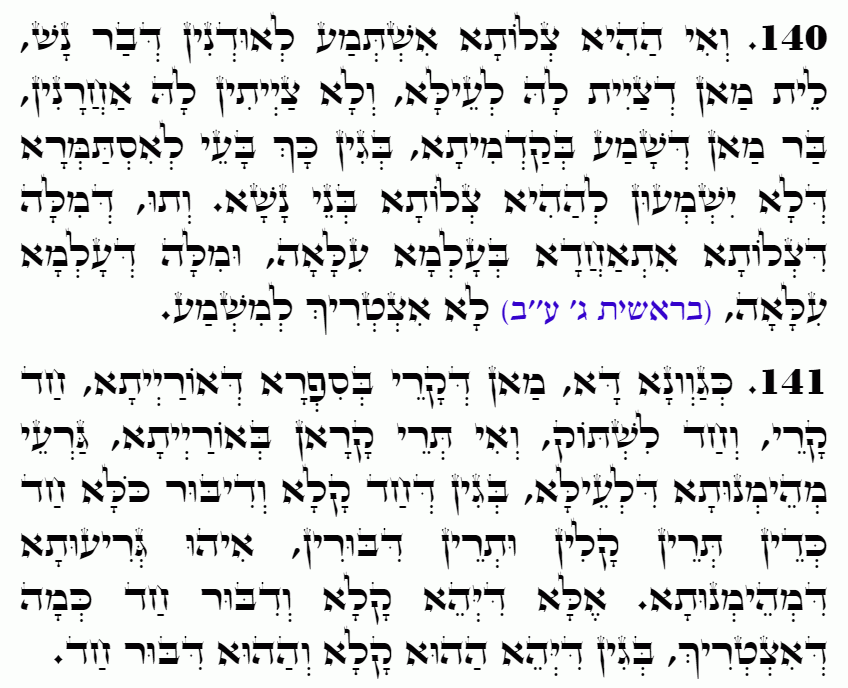Daily Zohar # 4490 – Vayakhel – Do not make a sound to be heard
Daily Zohar 4490

Hebrew translation:
141. כְּמוֹ זֶה מִי שֶׁקּוֹרֵא בְּסֵפֶר תּוֹרָה, אֶחָד קוֹרֵא וְאֶחָד לִשְׁתֹּק. וְאִם שְׁנַיִם קוֹרְאִים בַּתּוֹרָה, הֵם גּוֹרְעִים בָּאֱמוּנָה שֶׁלְּמַעְלָה, מִשּׁוּם שֶׁאֶחָד קוֹל וְאֶחָד דִּבּוּר הַכֹּל אֶחָד, אָז שְׁנֵי קוֹלוֹת וּשְׁנֵי דִבּוּרִים זוֹ גְרִיעוּת הָאֱמוּנָה. אֶלָּא שֶׁיִּהְיֶה קוֹל וְדִבּוּר אֶחָד כְּמוֹ שֶׁצָּרִיךְ, כְּדֵי שֶׁיִּהְיֶה אוֹתוֹ קוֹל וְאוֹתוֹ דִבּוּר אֶחָד.
.
Zohar Vayakhel
Continued from previous DZ studies of Vayakhel. We continue the study of the elevation of the prayers. I recommend going back to #121 or even #107 to study the meditations and the elevation process of our prayers.
#140
If that prayer is heard by a person’s ears, there is no one above who will accept it, and others will not listen to it except for the one who first heard it. For this reason, one must be careful not to let people hear the prayer. Furthermore, the speech of the prayer unites in the upper world, in Zeir Anpin, and the speech for the upper world should not be heard.
#141
Similarly, one person reads from the Torah scroll, and the other remains silent. If two people read from the Torah, it diminishes the faith above because voice and speech are one, but two voices and two speeches constitute a reduction and a flaw in faith, which is Malchut. Instead, there should be one voice and one speech as it should be, so that that voice, Zeir Anpin, which is called “קול” “voice,” and that “דיבור” speech, Malchut, which is called “speech,” will be one.
Lesson;
In the heightened realm of prayer, specifically during the Amidah, we maintain silence while subtly moving our lips as we recite the prayer silently. This practice aligns with the Atzilut level of spiritual connection, transcending sound. Being heard in this physical realm suggests a lack of faith in Hashem’s attentiveness to our prayers.
Our meditative stance is one of profound reverence, as though standing before the Holy One, Blessed be He. If our voices are audible, it risks ‘Grounding’ the prayer in the Malchut, preventing its acceptance above.
Similarly, during Torah reading, the reader vocalizes the text from the Torah scroll, corresponding to the Zeir Anpin level. Although the Torah is written without Nikkud (vowels) that ‘animate’ the words, it can be read aloud. In this context, the Torah or Zeir Anpin represents the “sound” (קול), and its verbal expression or “speech” (דיבור) manifests through Malchut.
The individual standing beside the reader recites the blessings but remains silent during the actual reading, moving their lips without producing sound. Speaking during the Torah reading is discouraged to prevent disrupting this vital connection.
Historically, the first person called to the Torah would recite the initial blessing, followed by five others who would approach the Torah silently, without reciting blessings. The final individual would then pronounce the concluding blessing, sealing the connection. Due to numerous interruptions, rabbis later mandated that blessings be recited at the start and end of each Aliyah to the Torah.
{||}

 Previous: Vayakhel
Previous: Vayakhel

